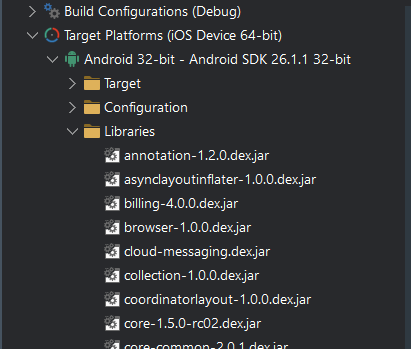-
Content Count
1629 -
Joined
-
Last visited
-
Days Won
37
Posts posted by Dave Nottage
-
-
Just now, William23668 said:Thanks I am reinstalling Delphi again now and will try
There's no instruction there to reinstall Delphi.
-
-
6 hours ago, kabiri said:But i can compile app for Development configuration (not for Application store or Ad Hoc).
Do you have a Provisioning Profile for App Store?
-
6 hours ago, Cesar Barbuda said:Java Type JFileProvider could not be found...
See:
-
7 hours ago, kabiri said:But I don't know what certificate I should use to build the program for Application store mode.
I think you mean Provisioning Profile, but given your comment here, you have resolved that now?
-
3 hours ago, kabiri said:But when the compilation is finished in Delphi, Delphi gives a message that the device was not found.
Have you installed PAServer? Please refer to: https://docwiki.embarcadero.com/RADStudio/Alexandria/en/Installing_the_Platform_Assistant_on_a_Mac
..and: https://docwiki.embarcadero.com/RADStudio/Alexandria/en/IOS_Mobile_Application_Development
-
2 hours ago, kabiri said:how can i test on iphone 6 (ios v12.4)?
One way would be to have a real device. What is the reason for wanting to test specifically on that?
2 hours ago, kabiri said:how can i add IOS SDK 12 to Delphi?(now i have SDK15.5)
You should not need to.
-
 1
1
-
-
1 hour ago, alogrep said:A to send more code, it is not feasible because is too long and nobody would take the time or have the patience to read it.
You could at least post the code for whatever the method is that starts with "ProcessH", as per my earlier comment. You provided a screenshot and said that is where the problem occurs.
-
17 minutes ago, alogrep said:However the call stack doesn't go inside the procedure where the problem actually happes.
Then the problem is not actually happening inside that procedure (though the root cause may be there). The problem is occurring in a method in the Http unit, in a class called TTCPHttpThrd in a method with a name starting with "ProcessH", but the rest of the callstack window is cut off in your screenshot
-
5 minutes ago, at3s said:Is it possible to access remotely to the Mac device where PAServer is running?
Or should this Mac be in the same LAN network where is the Delphi machine rather?
As long as the PAServer is exposed to the "outside world" (perhaps by port forwarding), yes.. that is possible. Bear in mind however that if you're deploying to a device, the machine that has PAServer on it needs to be able to access the device, either by being connected directly to that machine, or possibly using something like this: https://www.net-usb.com/
-
 1
1
-
-
14 hours ago, saeedbay said:an error message as follows. :
I doubt that error message (platform architecture issue) is related to the API level issue. It's possible that you're compiling for 64-bit and the installed OS is 32-bit. Be aware that some devices have a 64-bit CPU, but have a 32-bit Android OS installed.
-
 1
1
-
-
It may help to delete everything in the output folder(s) in question - by default they're Android/Debug (or Release) and Android64/Debug (or Release), then rebuild
-
The error message:
java.lang.ClassNotFoundException: Didn't find class "androidx.core.content.FileProvider"
Usually means that the jar that contains the class androidx.core.content.FileProvider was not included in your app. This class is in core-1.5.0-rc02.dex.jar, and should appear in the Libraries node, as per the instructions in my earlier reply. This is an example of what it should look like:

i.e. the package in question does not have a red "x" in the icon
-
1 hour ago, KMarb said:java.lang.RuntimeException: Unable to get provider androidx.core.content.FileProvider: java.lang.ClassNotFoundException: Didn't find class "androidx.core.content.FileProvider"
It's odd that you would receive that error on one device and not another. Regardless, please see this: https://github.com/DelphiWorlds/HowTo/tree/main/Solutions/AndroidLibraries
-
19 minutes ago, saeedbay said:I updated the SDK from the command line and defined the path of platform 33 in the sdkmanager of Delphi editor, but in theAndroidmanifest.xml file, the "targetSdkVersion" is still on the number 30, which means the previous platform.The targetSdkVersion value is whichever target API level Delphi currently supports, i.e. it is not determined by which API level you have selected. It should allow you to set this (see https://quality.embarcadero.com/browse/RSP-38976), however if you want it to be something different you'll need to change it in the AndroidManifest.template.xml file.
-
5 hours ago, microtronx said:I'm searching for a way, having multiple forms with different MainThreads in runtime instead of having multiple application-instances (exe files) started.
What is it that you think this will achieve?
-
9 minutes ago, at3s said:Can someone explain what exactly I have to do?
I suggest start reading, here: https://docwiki.embarcadero.com/RADStudio/Alexandria/en/IOS_Mobile_Application_Development
-
 1
1
-
-
26 minutes ago, KHJ said:I am a little bit confused by all the numbers and uncomplete dates:
Which parts are incomplete?
27 minutes ago, KHJ said:This version has the already mentioned version# 28.0.46141.0937 in the about box.
The version number in the about box changes only when there's a new major version or update (i.e. not a patch)
-
34 minutes ago, KenR said:I believe that https://github.com/DelphiWorlds/Kastri has a RichEdit component.
No, it doesn't. I wish it did 🙂
-
 1
1
-
-
3 minutes ago, limelect said:am I wrong?
Yes. I wrote it, so I would know. Also see line 58 of the code
-
 1
1
-
-
2 hours ago, ptlycldy said:The application is for an aid in decrypting those "Cryptoquote" puzzles found in newspapers, so maintaining the sentence/line-of-text structure is important.
Can you describe why it needs to be rich edit?
-
1 minute ago, limelect said:That's for Windows only.
-
22 minutes ago, schaumermal said:but NOT on the iPhone with IOS 16.1.1
It may be related to the model and iOS version. Please see: https://quality.embarcadero.com/browse/RSP-36095
-
 1
1
-
 1
1
-
-
6 hours ago, Randall Carpenter said:I am working on creating a API client using Delphi pascal. I have been unable to get it accept my POST request.
Posting the Delphi code that you are using might be helpful
![Delphi-PRAXiS [en]](https://en.delphipraxis.net/uploads/monthly_2018_12/logo.png.be76d93fcd709295cb24de51900e5888.png)


How I execute shell adb commands ?
in FMX
Posted
You execute them from the machine that is connected to the device. adb is in the platform-tools folder of the Android SDK